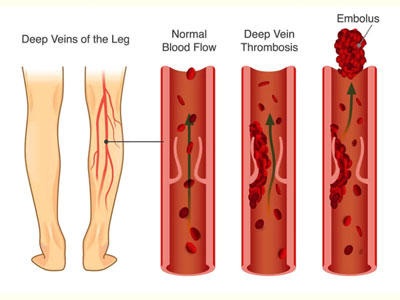Deep Vein Thrombosis


Symptoms
Deep Vein Thrombosis (DVT) is a serious vascular condition where a blood clot (thrombus) forms in a deep vein, most commonly in the legs. If left untreated, the clot can travel to the lungs, causing a life-threatening pulmonary embolism (PE). A Vascular & Endovascular Surgeon is a specialist trained to diagnose and treat DVT using advanced medical and minimally invasive techniques to restore blood flow and prevent complications.
About Deep Vein Thrombosis
DVT can occur due to prolonged immobility, injury to a vein, certain medical conditions, or genetic clotting disorders. Common symptoms include swelling, pain, warmth, and redness in the affected leg, though some cases may be asymptomatic. Early detection is crucial to prevent serious complications.
Treatment Goals
The primary aims of DVT treatment are:
- Prevent clot growth
- Stop new clots from forming
- Reduce the risk of pulmonary embolism
- Minimize the chance of long-term complications like post-thrombotic syndrome
Treatment Types for DVT
A Vascular & Endovascular Surgeon tailors the treatment plan based on the severity of the clot, patient’s health, and risk factors. Key treatment types include:
1. Anticoagulant Medications (Blood Thinners)- Oral or injectable medications to prevent clot growth and formation of new clots.
- Common options include heparin, warfarin, and newer direct oral anticoagulants (DOACs).
- Powerful clot-dissolving drugs administered directly into the vein.
- Used in severe DVT cases or when there is a high risk of pulmonary embolism.
- Catheter-Directed Thrombolysis: A minimally invasive procedure where a catheter delivers thrombolytic drugs directly into the clot.
- Mechanical Thrombectomy: Special devices break up and remove the clot through a catheter.
- A small device implanted in the large abdominal vein to prevent clots from traveling to the lungs.
- Recommended for patients who cannot take blood thinners.
- Use of compression stockings to improve blood flow, reduce swelling, and prevent long-term vein damage.
Why Consult a Vascular & Endovascular Surgeon?
These specialists combine medical therapy with advanced endovascular techniques to ensure effective, targeted treatment. Early consultation can significantly improve recovery and prevent life-threatening complications.
Book Your Consultation Today
Say goodbye to leg pain, swelling and blood clot.
- Clinics: Thane ( Ghodbunder road, Hiranandani estate, Kasarwadavali) and Mumbai
- Website: www.drriteshgaikwad.com
- Phone: +91-9619332942 / 9620962942
- Email: drriteshgaikwad19@gmail.com